
This page could not have attained its current level of completeness without the authoritative and generous contribution of Raymond Schoch, the son of Edwin and the author of "An Aviator", the biografy of his father.
The contents of this page were examined and approved by Raymond Schoch, and include some relevant comments from our e-mail correspondence.
Questa pagina non avrebbe potuito raggiungere il suo attuale livello di completezza senza il generoso e autorevole contributo di Raymond Schoch, figlio di Edwin e autore di "An Aviator", la biografia di suo padre.
I contenuti di questa pagina sono stati esaminati e approvati da Raymond Schoch, e includono alcuni suoi rilevanti commenti dalla nostra corrispondenza e-mail.
Click on any preview to enlarge the picture.
Fate click su qualsiasi anteprima per ingrandire l'immagine.
Edwin F. Schoch - Wikipedia Article (by Ray Schoch and Cesare Brizio) |
 |
Edwin F. Schoch - Articolo su Wikipedia (di Ray Schoch e Cesare Brizio) |
The only pilot ever to fly the XF-85 was Edwin F. Schoch, a McDonnell test pilot. Schoch, a graduate of Virginia Polytechnic Institute in 1941, enlisted in the Navy and was commissioned Ensign in April 1942.
He joined the flight program and in 1943 was assigned to VF-19, flying Grumman F6F Hellcats off the USS LEXINGTON.
He served with VF-19 for one tour of duty, claiming four Japanese airplanes destroyed and was awarded the Navy Cross, Distinguished Flying Cross, and the Air Medal.
He was flying Corsairs aboard the USS LAKE CHAMPLAIN with VFB-150 when the war ended.
Schoch then joined McDonnell as a test pilot, and thereafter flew nearly every type of airplane built by the company except the XP-67.
He was killed on a test flight of an F2H-3 in September 1951.
L'unico pilota a volare sull'XF-85 è stato Edwin F. Schoch, un pilota collaudatore McDonnell.
Schoch, diplomato al Virginia Polytechnic Institute nel 1941, si arruolò in Marina e fu nominato Guardamarina nell'Aprile del 1942.
Si è iscritto al programma per divenire pilota, e nel 1943 è stato assegnato a VF-19, volando con i Grumman F6F Hellcat della USS LEXINGTON.
Ha servito con il VF-19 per un ciclo di operazioni, abbattendo di quattro aerei giapponesi e venendo insignito di Navy Cross, Distinguished Flying Cross e Air Medal.
Alla fine della guerra, stava pilotando Corsair a bordo della USS LAKE CHAMPLAIN con il VFB-150.
Schoch si è poi impiegato alla McDonnell come pilota collaudatore, e da allora in poi ha volato praticamente su ogni tipo di aereo costruito dall'azienda eccetto l'XP-67.
Ha perso la vita nel volo di collaudo di un F2H-3 nel Settembre del 1951.
The planes on which his fame was built - Gli aerei su cui si è costruita la sua fama
Column-centered pictures can be enlarged by clicking.
Le immagini al centro della colonna possono essere ingrandite con un click.
|
|
|||
|
|
|||
|
|
|||
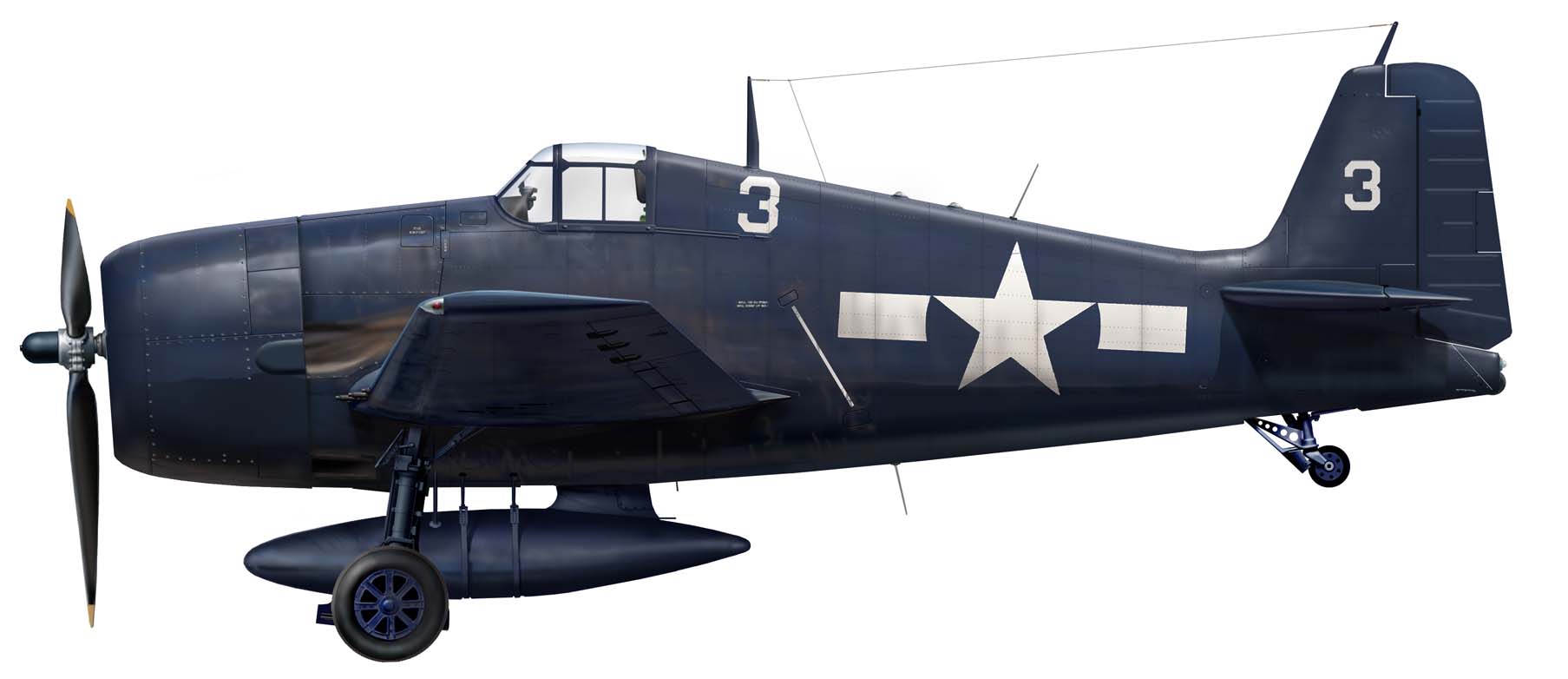 |
Grumman F6F-5 «Hellcat» (1944) [Image by Jim Laurier, courtesy of the Schoch Collection] |
(Comment by Raymond Schoch): «The F6F Hellcat was renowned among Navy pilots for being a forgiving plane to fly.<...>The painting of F6F-5 #3 shows a Hellcat my father flew on a strike mission in October, 1944. It was very badly shot up by Japanese antiaircraft fire - hit by 3 40mm shells. He nursed the crippled plane back to the Lexington, landed safely, and the plane was unrepairable, so it was pushed over the side into the Pacific.» |
(Commento di Raymond Schoch): «L'F6F Hellcat era rinomato tra i piloti della Marina come un aereo indulgente con il pilota.<...>Il dipinto dell'F6F-5 n. 3 mostra un Hellcat su cui mio padre volò in missione d'attacco al suolo nell'ottobre del 1944. Fu gravemente colpito dal fuoco antiaereo giapponese - raggiunto da 3 proiettili da 40 mm. Ha riportato l'aereo danneggiato fino alla Lexington, è atterrato in sicurezza e l'aereo non è stato riparabile, quindi è stato spinto fuori bordo nel Pacifico.» |
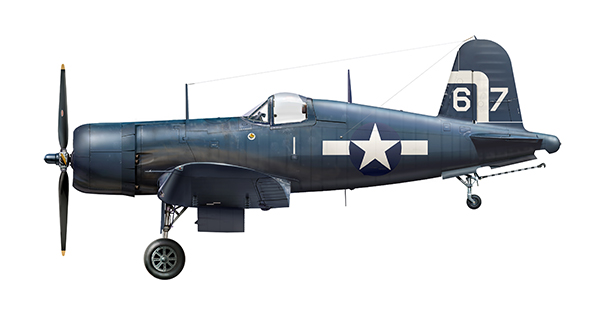 |
Vought F4U-4 «Corsair» (1945) [Image by Jim Laurier, courtesy of the Schoch Collection.] |
(Comment by Raymond Schoch): «The F4U-4 Corsair he flew throughout the remainder of the war was a versatile aircraft, and an improvement over the F6F he'd flown in combat - it was a very capable fighter plane in its own right, and could haul at least as much of a bomb load as the F6F, while flying about 50 mph (80 kph) faster. But it was also more temperamental / difficult to fly.<...>The Corsair was tricky, especially at low speed (while landing aboard a carrier).<...>The rudder of #67 displays a stripe that was used for squadron identification by other aircraft and by ships in the fleet.» |
(Commento di Raymond Schoch): «Il Corsair F4U-4 su cui ha volato per il resto della guerra era un velivolo versatile, e un miglioramento rispetto all' F6F su cui aveva volato in combattimento - era un aereo da caccia molto capace di per sé, e poteva trasportare almeno altrettanto carico di bombe dell'F6F, volando circa 50 mph (80 km/h) più veloce. Ma era anche più instabile / difficile da pilotare.<...>Il Corsair era difficile, specialmente a bassa velocità (nell'atterraggio su portaerei).<...>Il timone del numero 67 mostra una striscia utilizzata per l'identificazione dello squadrone da altri velivoli e dalle navi della flotta.» |
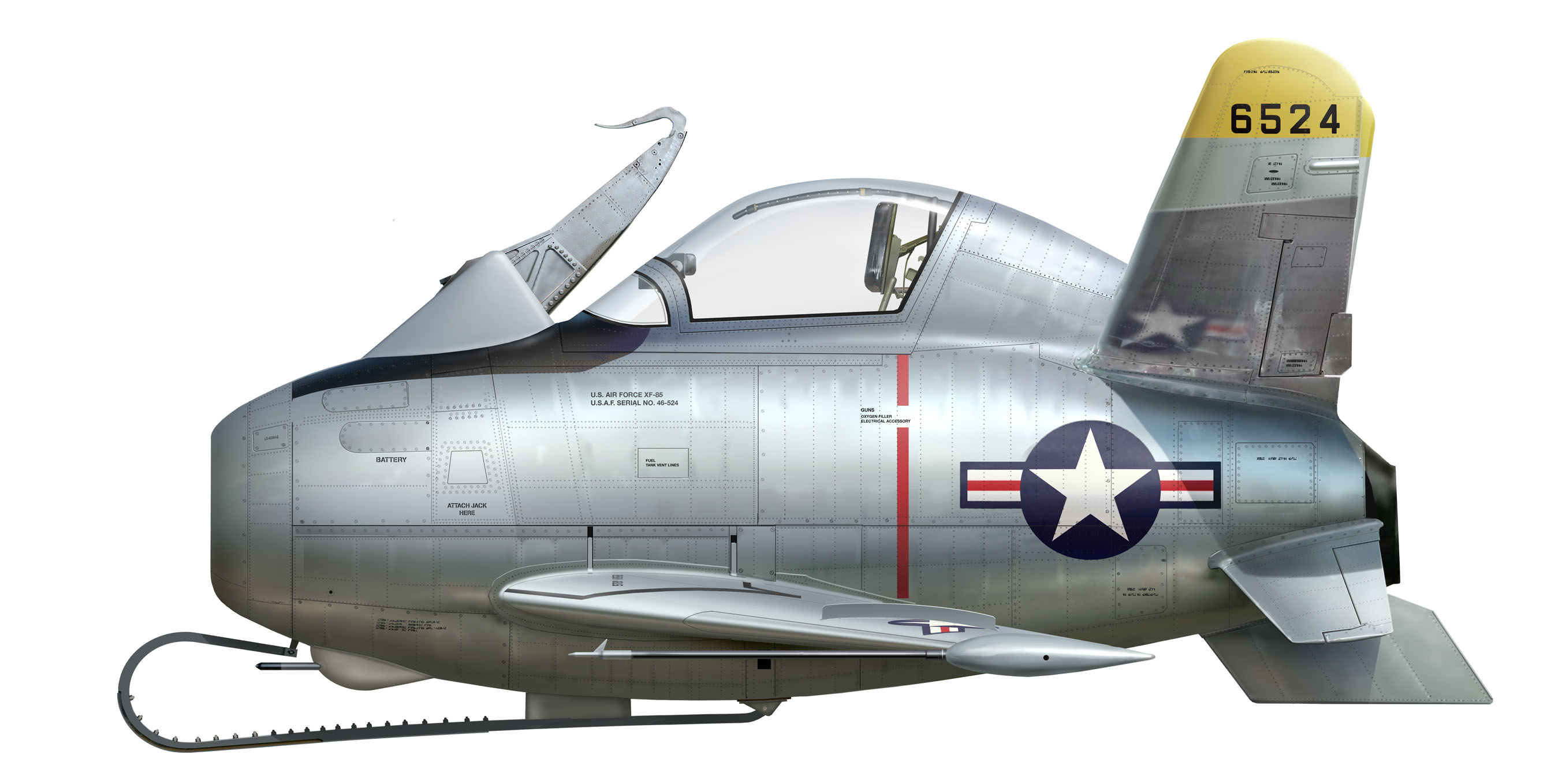 |
McDonnell XF-85 «Goblin» (1948) [Image by Jim Laurier, courtesy of the Schoch Collection.] |
(See the dedicated web pages) |
(Vedere le pagine Web dedicate) |
|
A few pictures of Ed Schoch from other pages of "The Goblinarium" Alcune foto di Ed Schoch da altre pagine di "The Goblinarium" |
|||
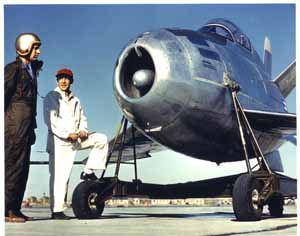 |
Ed Schoch in front of the McDonnell XF-85 Goblin |
The classic image in the McDonnell public information card about the Goblin |
La classica immagine nella scheda di informazioni al pubblico della McDonnell relativa al Goblin |
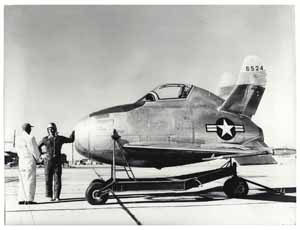 |
Ed Schoch in front of the McDonnell XF-85 Goblin |
Another image, this time in B/W, from the same photographic session |
Un'altra immagine, stavolta in B/N, dalla stessa sessione fotografica |
426A-G-4144BU_800.jpg) |
Ed Schoch on board the McDonnell XF-85 Goblin |
Ed Schoch on the Goblin, positioned on its handling dolly. |
Ed Schoch sul Goblin, posizionato sul suo carrello di movimentazione. |
D4E-13188_800.jpg) |
Ed Schoch on board the McDonnell XF-85 Goblin |
Ed Schoch on the Goblin, positioned on its handling dolly. |
Ed Schoch sul Goblin, posizionato sul suo carrello di movimentazione. |
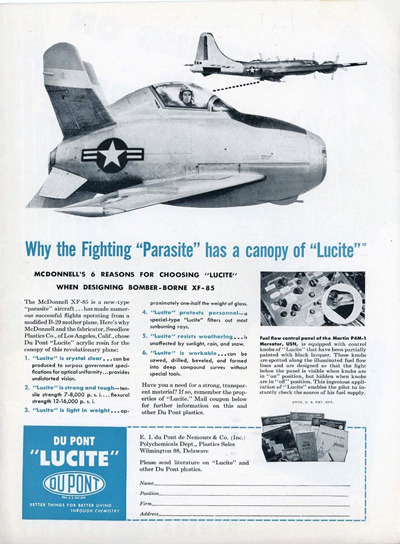 |
"Lucite" advertising |
The advertising of "Lucite" - most probably, a photomontage from one of the official McDonnell pictures taken with the Goblin on its handling dolly. |
la pubblicità del Plexiglas - molto probabilmente, un fotomontaggio tratto da una delle immagini ufficiali McDonnell ripresa con il Goblin sul suo carrello di movimentazione. |
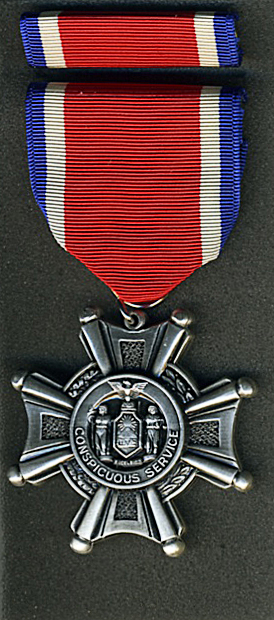 |
New York Conspicuous Service Cross (2020) [Photo courtesy of the Schoch Collection] |
Awarded for «rendering conspicuous service to our people» |
Conferita per «aver reso un cospicuo servizio al nostro popolo» |
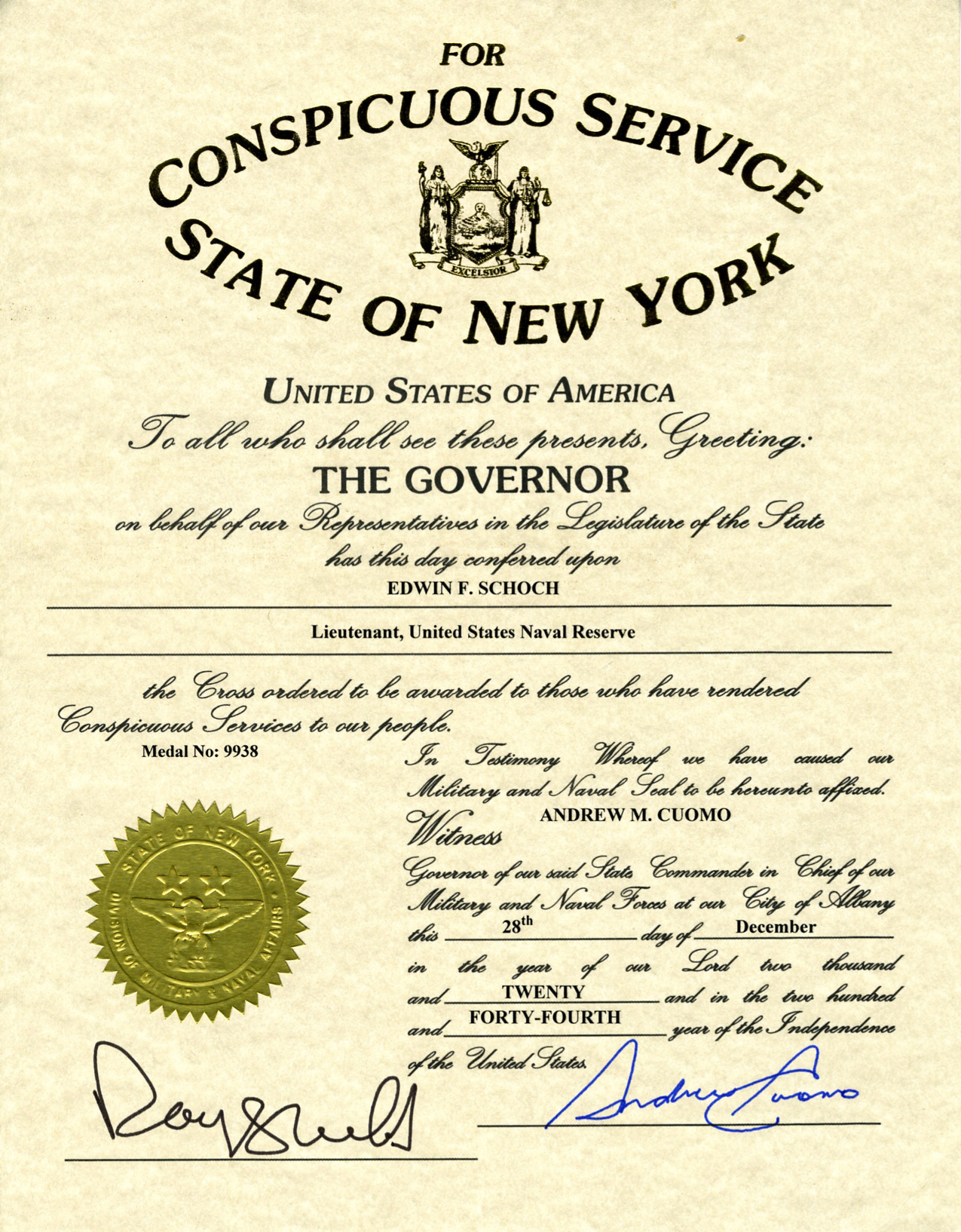 |
|||
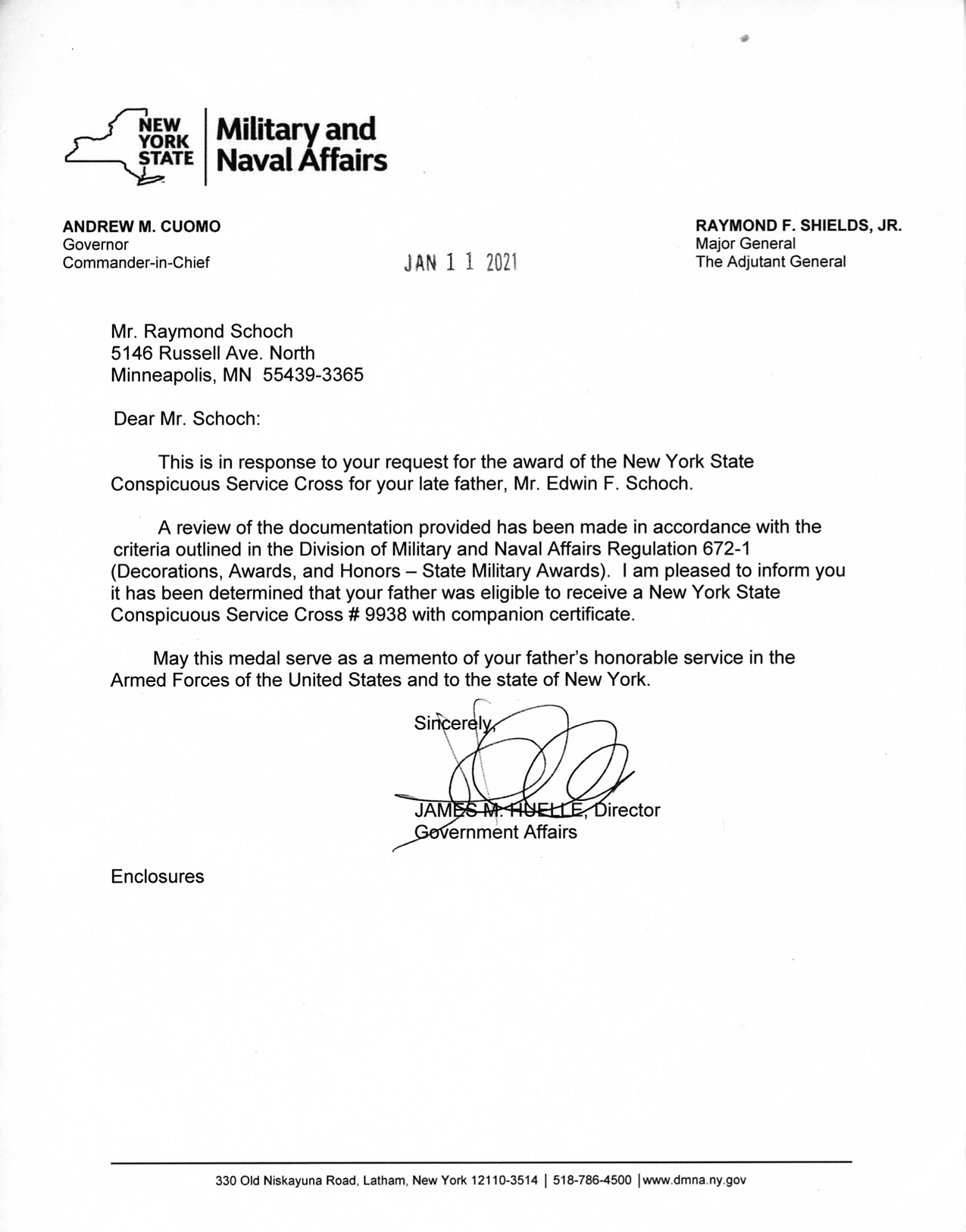 |
|||
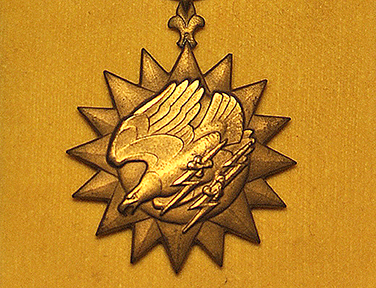 |
Air Medal (1944) [Photo courtesy of the Schoch Collection] |
Awarded for «Meritorious achievement while participating in aerial flight from 10 July to 23 October 1944» |
Conferita per «Risultati meritori nel partecipare a attività di volo tra il 10 Luglio e il 23 Ottobre 1944» |
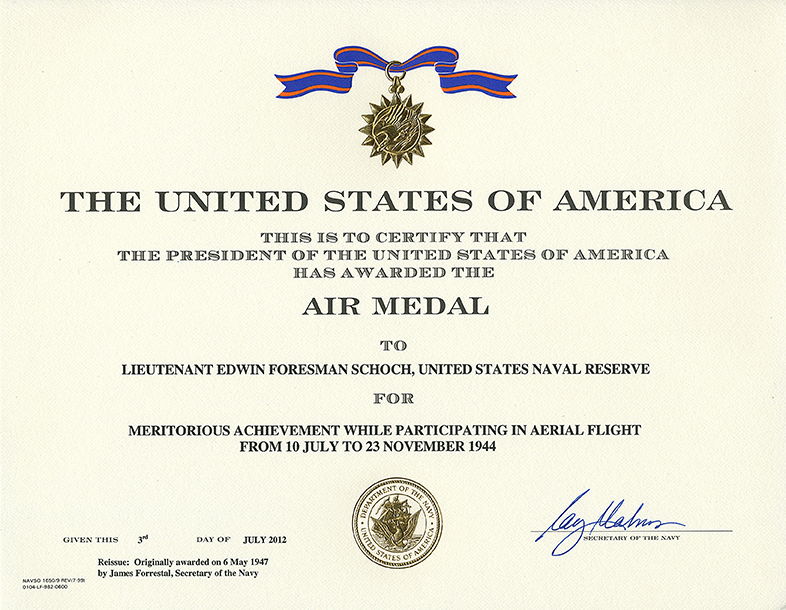 |
|||
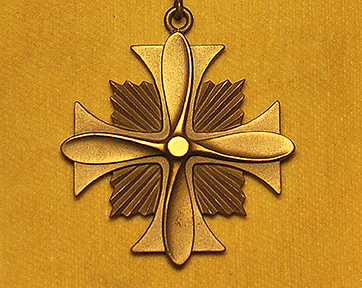 |
Distinguished Flying Cross (1944) [Photo courtesy of the Schoch Collection] |
Awarded for «Extraordinary achievement while participating in aerial flight on 24 October 1944» (that day, Edwin F. Schoch downed three Japanese airplanes) |
Conferita per «Straordinari risultati nel partecipare a attività di volo il 24 Ottobre 1944» (quel giorno, Edwin F. Schoch ha abbattuto tre aerei Giapponesi) |
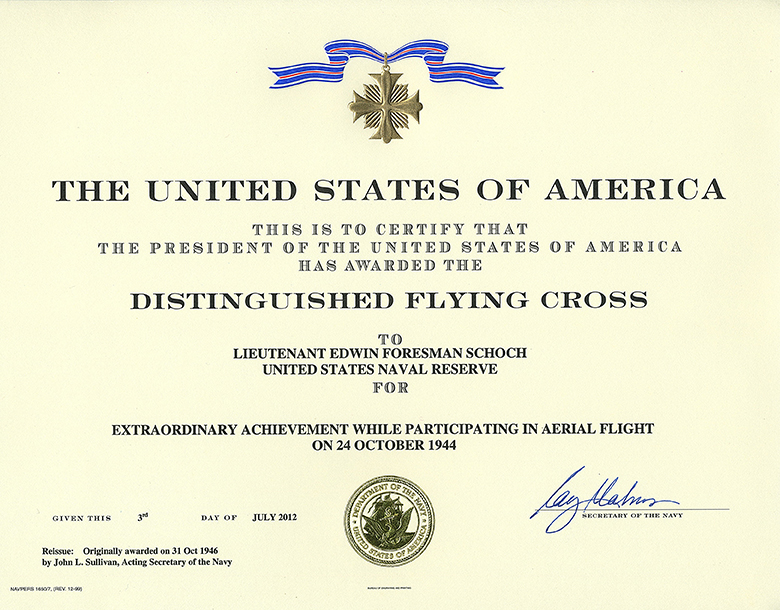 |
|||
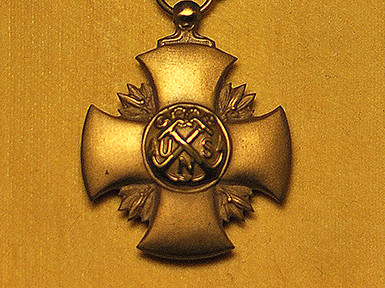 |
Navy Cross (1946) [Photo courtesy of the Schoch Collection] |
Awarded for «Extraordinary Heroism while engaged in military operations»(Comment by Raymond Schoch): «I should note - careful reading will reinforce this - that the citation for the medal is incorrect. It states that my father put a bomb into a Japanese battleship, but that is not the case. He hit the Japanese light carrier Zuiho with a 500-lb (225 kg) semi-armor-piercing bomb. <...> the bomb blast bulged the rear elevator above the flight deck, making landing (and thus flight operations) impossible for the ship's remaining hours. <...> That bomb hit is likely one of the reasons why he was assigned to VBF-150 after his Christmas leave ended in January, 1945 - he'd already shown some ability in that regard.» |
Assegnata per «Straordinario Eroismo nello svolgimento di operazioni militari»(Commento di Raymond Schoch): «Devo osservare - e un'attenta lettura lo confermerà - che la citazione per la medaglia è errata. Afferma che mio padre ha piazzato una bomba in una corazzata giapponese, ma non è così. Colpì la portaerei leggera giapponese Zuiho con una bomba semi-corazzata da 225 kg. <...> l'esplosione della bomba ha spinto l'ascensore posteriore sopra il ponte di volo, deformandolo e rendendo impossibile l'atterraggio (e quindi le operazioni di volo) per le restanti ore della nave. <...> Quel colpo di bomba è probabilmente uno dei motivi per cui è stato assegnato a VBF-150 (nota: squadrone da bombardamento) dopo che il suo congedo di Natale è terminato nel gennaio del 1945 - aveva già mostrato qualche abilità in tal senso.» |
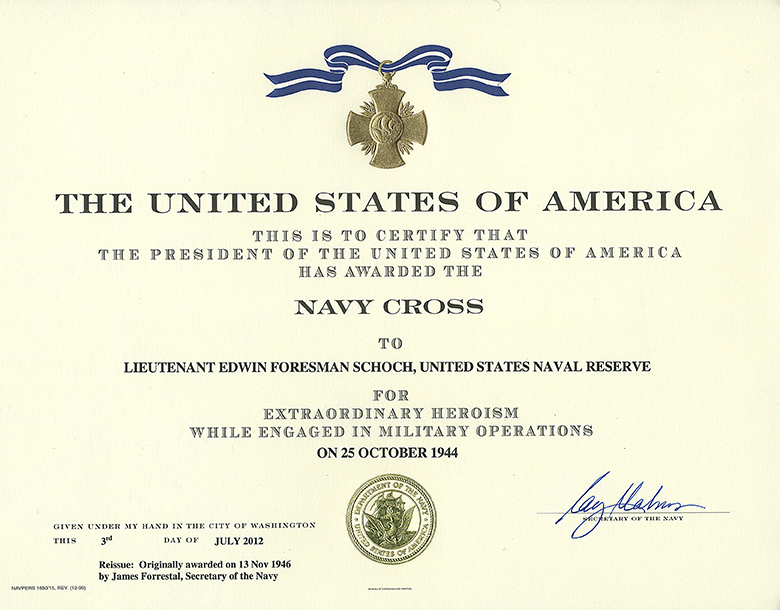 |
|||
Page-centered pictures can be enlarged by clicking.
Le immagini al centro della pagina possono essere ingrandite con un click.
DATE OF BIRTH: September 13, 1916
PLACE OF BIRTH: Oakmont, Pennsylvania
HOME OF RECORD: Ebenezer, New York
Service: Navy
Battalion: Fighter Squadron 19 (VF-19)
Division: U.S.S. Lexington (CV-16)
GENERAL ORDERS: Commander 1st Carrier Task Force: Serial 0765 (October 30, 1944)
CITATION:
The President of the United States of America takes pleasure in presenting the Navy Cross to Lieutenant Edwin Foresman Schoch (NSN: 0-116528), United States Naval Reserve, for extraordinary heroism in operations against the enemy while serving as Pilot of a carrier-based Navy Scout Dive Bomber in Bombing Squadron NINETEEN (VB-19) attached to the U.S.S. LEXINGTON (CV-16), while assigned to strike major Japanese Fleet Units on 25 October 1944, during the Battle of Leyte Gulf, in the Philippine Islands. Lieutenant Schoch aggressively and skillfully dove through intense anti-aircraft fire to strafe and accurately bomb a battleship. Severe damage was inflicted on the battleship and it slowed perceptibly after this attack. His courage and skill were at all times in keeping with the highest traditions of the United States Naval Service.
DATA DI NASCITA: 13 Settembre, 1916
LUOGO DI NASCITA: Oakmont, Pennsylvania
SEDE DI REGISTRAZIONE: Ebenezer, New York
Servizio: Marina
Battaglione: Fighter Squadron 19 (VF-19)
Divisione: U.S.S. Lexington (CV-16)
REGISTRO GENERALE: Commander 1st Carrier Task Force: Serial 0765 (October 30, 1944)
CITAZIONE:
Il presidente degli Stati Uniti d'America è lieto di conferire la Croce della Marina al tenente Edwin Foresman Schoch (NSN: 0-116528), Riserva Navale degli Stati Uniti, per l'eroismo straordinario nelle operazioni contro il nemico durante il suo servizio come Pilota di un cacciabombardiere in picchiata della Marina nello squadrone da bombardamento DICIANNOVE (VB-19) basato sulla USS LEXINGTON (CV-16), mentre svolgeva l'incarico di colpire le principali unità della flotta giapponese il 25 ottobre 1944, durante la battaglia del Golfo di Leyte, nelle Isole Filippine. Il tenente Schoch si è lanciato aggressivamente e abilmente attraverso un intenso fuoco antiaereo per mitragliare e bombardare con precisione una nave da guerra. Furono inflitti gravi danni alla nave da guerra, che ha rallentato sensibilmente dopo questo attacco. In ogni momento, il suo coraggio e la sua abilità sono state in linea con le più alte tradizioni del servizio navale degli Stati Uniti.
Lieutnant Edwin F. SCHOCH, USNR, 28, of 109 Hollywood Ave., Buffalo, N.Y., is the squadron's Engineering Officer, and a former fighter pilot with VF-19. While aboard the Lexington he was awarded th Distinguished Flying Cross for destroying three (3) Japanese aircraft in one day 24 October 1944, two Tojos over Luzon and one Zeke over the Task Group. On 25 October 1944 Lieutenant SCHOCH got a 500lb bomb hit on the Jap carrier ZUIHO and for this act was awarded the Navy Cross. He attended High School in Buffalo, N.Y. and matriculated at the Virginia Polytechnic Institute where he majored in Mechanics. His wife Arlene Whelply SCHOCH and their seven month old son, Raymond, live in Buffalo, N.Y.
Recovered from the National Archives - https://catalog.archives.gov/id/77650058
Il tenente Edwin F. SCHOCH, USNR, 28 anni, di 109 Hollywood Ave., Buffalo, N.Y., è l'Ufficiale Tecnico dello squadrone ed è un ex pilota di caccia con il VF-19. Mentre era a bordo della Lexington gli fu assegnata la Distinguished Flying Cross per aver distrutto tre (3) aerei giapponesi in un giorno il 24 ottobre 1944, due Tojos su Luzon e uno Zeke sul Task Group. Il 25 ottobre 1944 il tenente SCHOCH ha piazzato una bomba da 500 libbre sulla portaerei Giapponese ZUIHO e per questo atto ha ricevuto la Croce della Marina. Ha frequentato la High School di Buffalo, New York e si è iscritto al Virginia Polytechnic Institute dove si è specializzato in Meccanica. Sua moglie Arlene Whelply SCHOCH e il loro figlio di sette mesi, Raymond, vivono a Buffalo, New York.
Recuperato dagli Archivi Nazionali - https://catalog.archives.gov/id/77650058
Beyond the Goblin - Oltre al Goblin
Click on any preview to enlarge the picture.
Fate click su qualsiasi anteprima per ingrandire l'immagine.

Edwin F. Schoch in the cockpit of the first McDonnell XF-88 Voodoo (Bu. No. 46-525).
Date unclear, the test program at Muroc/Edwards AFB took most of 1949 and the first
half of 1950, before the fly-off Penetrator Fighter Competition held on 29 June
and 7 July 1950, that the XF-88A won against the Lockheed XF-90 and the North American
YF-93A, even though ultimately no penetration fighter was procured by the Air Force.
[Photo courtesy of the Schoch Collection]
Edwin F. Schoch nel cockpit del primo McDonnell XF-88 Voodoo (Bu. No. 46-525).
Data non chiara, il programma di test a Muroc/Edwards AFB ha preso gran parte del 1949 e
la prima metà del 1950, prima della competizione "fly-off" Penetration Fighter
svoltasi il 29 Giugno e il 7 Luglio 1950, che l'XF-88A ha vinto contro il Lockheed XF-90
e il North American YF-93A, anche se in definitiva nessun "caccia da penetrazione" fu
acquisito dall'Air Force. [Photo courtesy of the Schoch Collection]
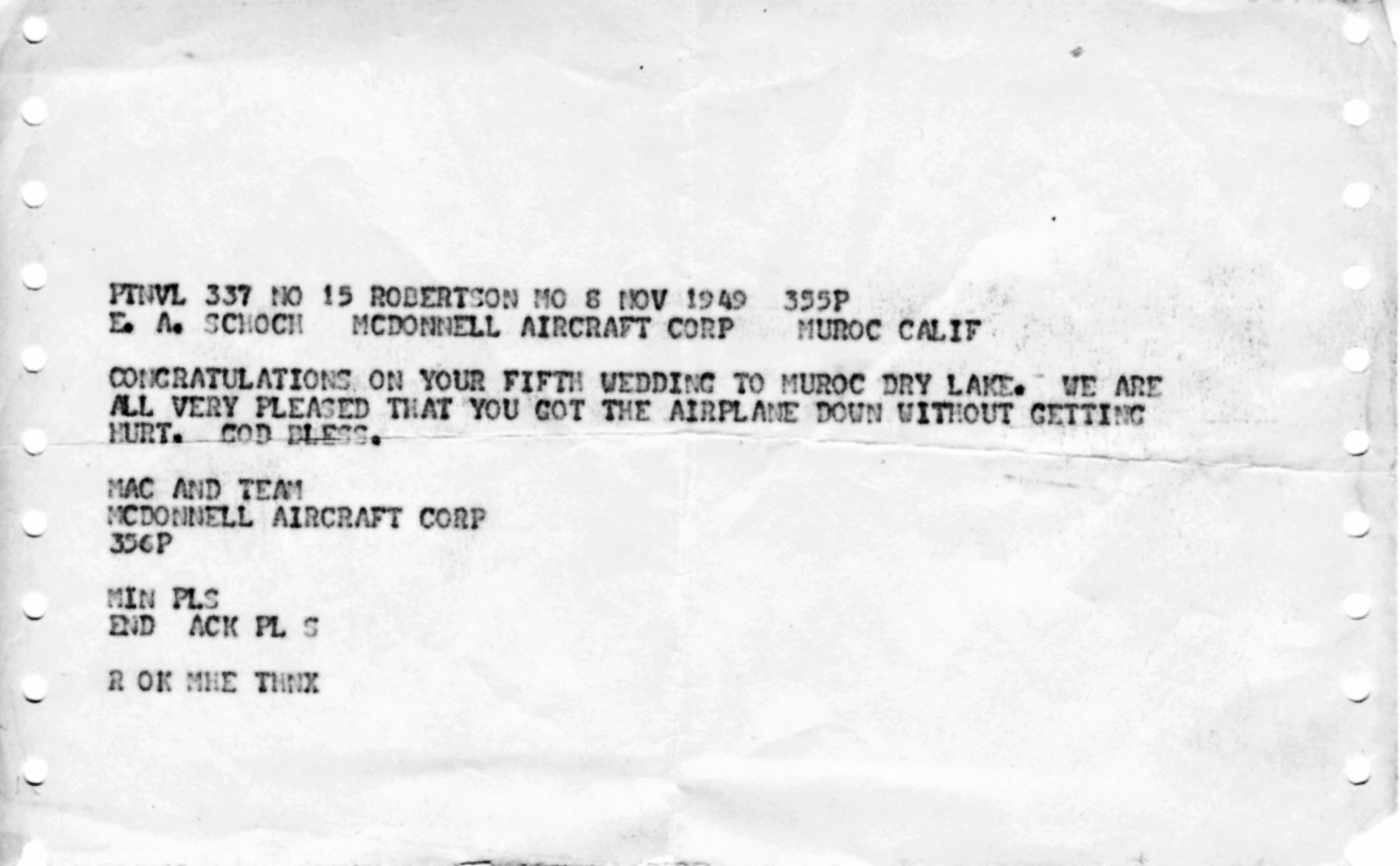
The role of Ed Schoch in the flight tests of the first McDonnell XF-88 Voodoo (Bu. No. 46-525) is testified by this telegram, received on 8 November 1949.
Mr. Mac himself hints at Ed's "fifth marriage" with the ground, after the four successful landings with the Goblin.
Several sources (including the monograph by Steve Pace, Air Force Legends Number 205) report an accident to the XF-88 occurred
at Edwards around the same date, but give no details.[Photo courtesy of the Schoch Collection]
Il ruolo di Ed Schoch nei test del primo McDonnell XF-88 Voodoo (Bu. No. 46-525) è testimoniato da questo telegramma, ricevuto l'8 Novembre 1949.
È lo stesso Mr. Mac ad accennare al "quinto matrimonio" di Ed con il suolo, dopo i quattro atterraggi riusciti con il Goblin.
Diverse fonti (tra cui la monografia di Steve Pace, Air Force Legends Number 205) riferiscono di un incidente all'XF-88 occorso
a Edwards attorno alla stessa data, ma non forniscono dettagli. [Photo courtesy of the Schoch Collection]
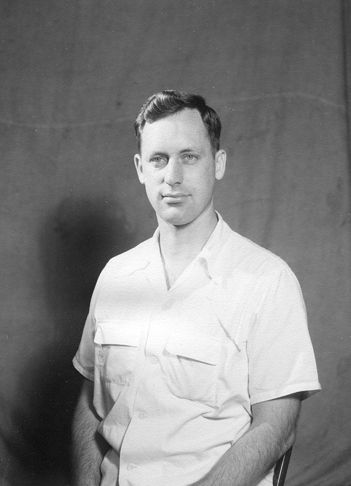
Edwin F. Schoch at 34 years of age, in 1951. [Photo courtesy of the Schoch Collection]
Edwin F. Schoch a 34 anni di età, nel 1951. [Photo courtesy of the Schoch Collection]
Elsberry, Mo. - A navy jet Banshee fighter plane crashed and burned near here Friday(*), killing its pilot - tentatively identified as Edwin Schoch, 35 of St. Louis.
McDonnell Aircraft Corp. of St. Louis said Schoch, a test pilot, was flying in the Elsberry area Friday morning and he is presumed to have been involved in the mishap.
Serial numbers of the plane check with those of Schoch's craft, a company spokesman said. McDonnell manufactures Banshees.
Schoch was a navy fighter pilot in the Pacific in World war II and had four Jap planes to his credit. He was married and the father of four children ranging in age from one to seven.
The plane crashed in a wooded area on the farm of J.K. Waters, about seven miles southwest of Elsberry.
A rural mail carrier, Johnny W. Mays, said the plane "blew up in the air" before it plummeted to earth at about 10:05 a.m. He reported that the wreckage was strewn over a wide area.
Another witness said he saw a man's arm dangling from the blazing cockpit.
Elsberry is about 60 miles northwest of St. Louis.
(*) The newspaper came out on Friday 14 September 1951, and refers to the previous day, Thursday 13 September.
Elsberry, Mo. - Un aereo a reazione da caccia Banshee della marina si è schiantato e bruciato qui vicino Venerdì(*), uccidendo il suo pilota - provvisoriamente identificato come Edwin Schoch, 35 anni, di St. Louis.
La McDonnell Aircraft Corp. di St. Louis ha detto che Schoch, un pilota collaudatore, stava volando nell'area di Elsberry Venerdì mattina e si presume sia stato coinvolto nell'incidente.
I numeri di serie dell'aereo corrispondono con quelli del velivolo di Schoch, ha detto un portavoce della compagnia. La McDonnell produce i Banshee.
Schoch è stato pilota da combattimento della Marina nel Pacifico durante la seconda guerra mondiale e aveva al suo attivo quattro aerei giapponesi. Era sposato e padre di quattro figli di età compresa tra uno e sette anni.
L'aereo si è schiantato in una zona boscosa nella fattoria di J.K. Waters, a circa sette miglia a sud-ovest di Elsberry.
Un corriere della posta rurale, Johnny W. Mays, ha detto che l'aereo "è esploso in aria" prima di precipitare al suolo verso le 10:05 circa. Ha riferito che il relitto era sparso su una vasta area.
Un altro testimone ha detto di aver visto il braccio di un uomo penzolare dall'abitacolo in fiamme.
Elsberry si trova a circa 60 miglia a nord-ovest di St. Louis.
(*) Il giornale è uscito Venerdì 14 Settembre 1951, e si riferisce al giorno precedente, Giovedì 13 Settembre.
❦